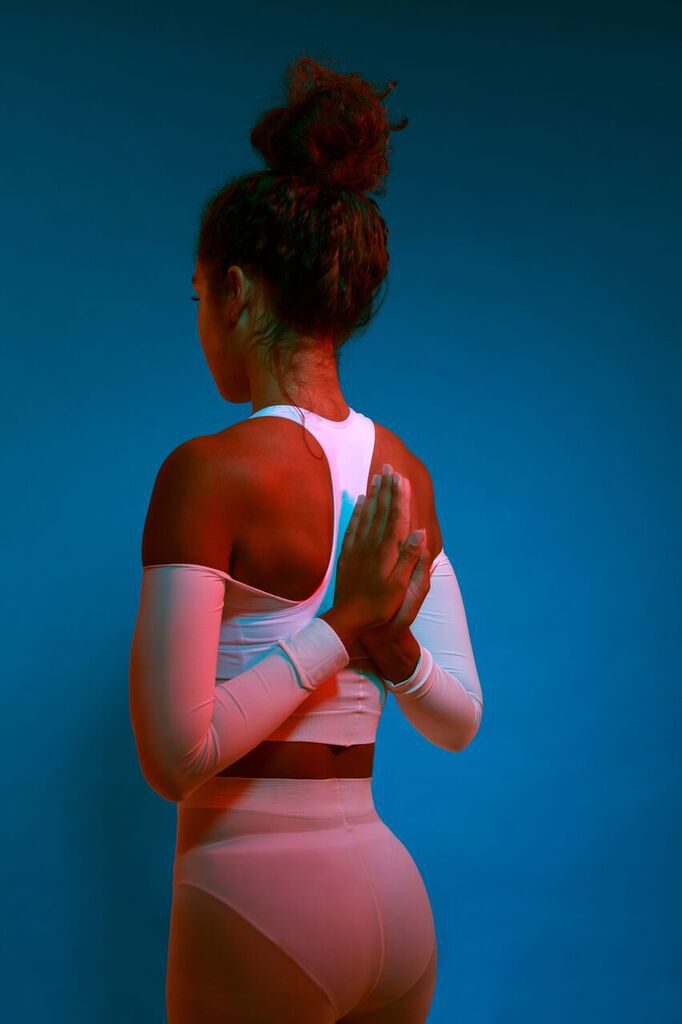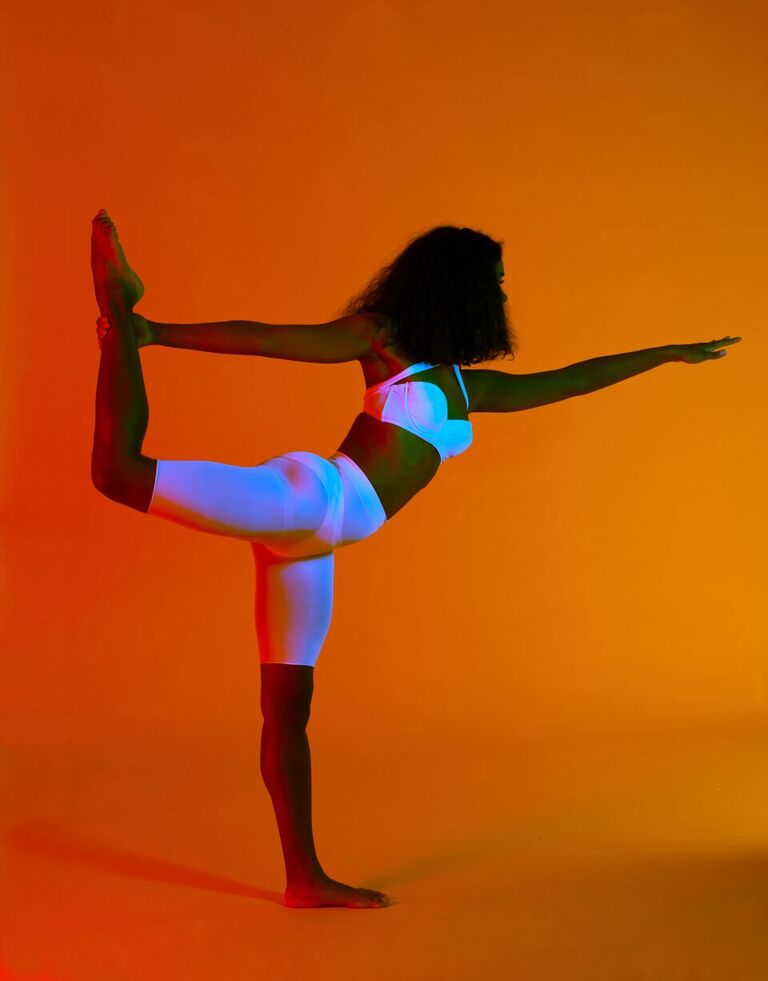Chroma Yoga: Meet the entrepreneur who is bringing a whole new spectrum of benefits to yoga
Nina Ryner’s studio in Shoreditch is pioneering an approach to Yoga that combines the ancient practice with futuristic uses of light, colour, scent and sound.
`By Rute Costa
I find Nina Ryner sitting behind the desk at the reception of her innovative yoga studio in Shoreditch. Chroma Yoga, Nina’s brainchild, opened its doors to the world in 2017. It offers a fresh approach to yoga, combining the physical and mental benefits of the ancient practice with modern technologies of colour and light therapy. The surrounding scents and soundscapes curated especially for the purpose make for a unique multisensory experience.
We sit down for a chat between classes. Through a door I catch a glimpse of an empty white room that changes colour and makes the yoga mats and blocks on the floor seem to be part of an art installation. I am suddenly more curious, and I ask Nina how the idea for Chroma Yoga came about. “My last job before this was as a fashion designer, I’ve got my own label, and I’ve always worked for myself. My main interest is thinking of ideas that haven’t been done before and making them happen. So I’m not a yoga teacher – everyone thinks I’m a yoga teacher but I’m not, I’m not even very good at yoga”, she tells me.
Nina explains that whilst she was a fashion designer she was also working for a yoga events company, and taking more classes than ever. “I’d never done any type of fitness at all until a certain point in my life, and then I did it obsessively”, Nina says. After trying out many studios in London, she realised something: “I didn’t really like them, I couldn’t relate to them. They were all a bit cheesy, or commercial, or really outdated and new age. I could never really find a good balance”. Simultaneously, she was brainstorming yoga event ideas for her job. Then, something clicked.
“I thought it was really obvious: putting yoga with colour. I just thought someone would have done it before.”

“I thought it was really obvious: putting yoga with colour. I just thought someone would have done it before”, Nina says. After a lot of research, she not only found out that no one had, but also that the benefits were countless. “It’s quite a niche, ‘out there’ thing to think ‘oh, if I shine some red light on me, I’m never gonna age again’. It’s quite hard to convince people that it’s actually a thing”. However, “extensive scientific research” has found the multiple effects different light frequencies have on the body and mind. Blue light is especially beneficial in winter mornings: it reduces the the symptoms of Seasonal Affective Disorder, reduces tiredness and boosts productivity. Red light increases energy generation on a cellular level: it increases alertness, promotes a healthy sleep cycle and soothes inflamed muscular tissue. The colourful list goes on and on.
Each class is designed around a colour of light and its impact. A Pink class, for example, is restorative, focused on stretching and breath works, due to the colour’s associations with love, nurturing and affection. Nina worked closely with her friend and yoga teacher Clara Baker to apply her research on light therapy and create a template for each ‘coloured’ class. “I didn’t want the classes to veer away from the traditional element of [yoga], I didn’t want to appropriate anything, I just wanted to pair something which I saw as quite modern and futuristic, with something which is a very popular way of physically and mentally healing yourself”, she says.
Nina’s research also extended to the topic of sound. “A lot of yoga teachers just put on their own music and if they have bad taste in music then it’s really off-putting and you can’t concentrate. […] I wanted these 360 soundscapes to be involved, to be subtle and in the background”, she explains. To combat her pet-peeve of ‘off-putting’ music, Nina looked into the types of sound frequencies that can “hack your brain and push you into a trance state, into a state where you can concentrate properly and get all the emotional benefits [from yoga and meditation]”. She collaborated with Tim Goalen, a sound designer, to layer isochronic tones within the tracks. To finish designing the full multisensory experience of Chroma Yoga, Nina partnered up with Asakala to create unique scents.
“I didn’t want the classes to veer away from the traditional element of [yoga], I didn’t want to appropriate anything, I just wanted to pair something which I saw as quite modern and futuristic, with something which is a very popular way of physically and mentally healing yourself”
The result is a fully immersive experience that shuts out the outside world, and allows busy-minded millennials to really be present in their sensations. Chroma Yoga attracts a variety of people: among customers there are creatives who enjoy the multisensory experience, first-time yogis, or experienced yogis looking to refresh their practice. Nina wants to counteract the cliched “white, westernised, commercial outlook” of yoga that alienates so many people from the practice, and instead offer something “modern and forward-thinking”. The success of this approach has been such that Nina can’t get into her own studio’s sold-out classes: “Which is good, but bad for my back”, she says.

New York is now part of Chroma Yoga’s future plans. “It was really nice, being able to present Chroma Yoga on a small scale to a different audience, so I’d really like to open a studio there. And obviously all over the world”. Nina tells me the business model is “pretty expandable” as it is, but she doesn’t want to settle. Constantly looking for “things you haven’t seen before”, she plans to carry on researching and staying ahead of the game. Their newest addition to the Chroma Yoga timetable is Ganzsound, “a totally different approach to meditation”.
I ask Nina what Ganzsound meditation is. “It’s a mix of sensory deprivation, colour perception, and those sound frequencies that I was mentioning before. It’s teacherless, you just put some headphones on, lie down, close your eyes and let the light filter through, while you listen to this soundscape that my friend Heloise Tunstall-Behrens, who is a musician, has composed”, she explains. The method was inspired by the ‘ganzfeld effect’, a form of perceptual deprivation that causes the brain to amplify neural noise in order to search for the missing sensory signals it’s so used to. It causes sensations of deep relaxation, lucid dreaming and synaesthesia. Just as we are wrapping up the interview, Nina invites me to try it out. There is a class starting in five minutes, and I take the offer. All I can say is: go try it for yourself. You might meet me there.

Photo credits: Stephanie Sian Smith / ChromaYoga
